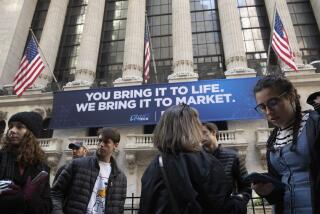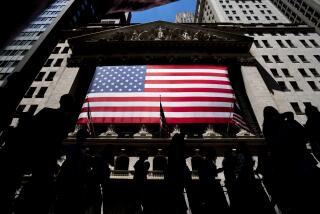Stock rally takes a pause, ends week up only slightly
NEW YORK — Even the stock rally may need a summer vacation.
Investors have been pouring back into stocks this month, pushing major U.S. stock indexes up more than 4% in July. But the rally took a bit of a respite over the last five days, ending the week up only slightly.
“The market is just taking a pause,” said Paul Zemsky, head of multi-asset strategies for ING U.S. Investment Management in New York. Stocks’ July gains still amount to “a pretty big move in one month.”
The Dow Jones industrial average added only 3.22 points, or 0.02%, to 15,558.83 on Friday as Chinese leaders rekindled worries over growth and a credit bubble in the world’s second-largest economy. Investors worry that a slowing Chinese economy could spill over into the country’s trading partners.
The broader Standard & Poor’s 500 index ticked up 1.4 points, or 0.08%, to 1,691.95, while the technology-heavy Nasdaq composite index gained 7.98 points, or 0.22%, to 3,613.16.
Money flows into the stock market have slowed since early July. Investors poured a hefty $3.8 billion into equity funds in the week that ended July 17, but that was far less than the $7.6-billion surge the previous week, according to data compiled by the Investment Company Institute.
Despite the slowdown, bullish Wall Street analysts expect stocks to continue their climb this year. Zemsky projects that the S&P; 500 will end the year around 1,750 — but that depends on whether U.S. economic growth picks up steam in the second half of the year.
Public companies this month have been telegraphing the economy’s direction.
Corporate profits have generally been surprising Wall Street, and second-quarter earnings for the average S&P; 500 company are projected to rise 4.5%, up from July 1 estimates of about 2.9%, according to research firm S&P; Capital IQ.
Corporate profits will also tell investors whether this year’s meteoric climb in stock prices is justified or if stocks are getting overheated. U.S. stocks are up nearly 19% for the year.
For now, commonly used measures of stock values indicate that stocks are no longer bargains. But prices are not showing signs of getting too expensive either, analysts say.
“They’re not compelling but they’re attractively priced,” said Sam Stovall, chief equity strategist for S&P; Capital IQ.
One measure, the S&P; 500’s price-to-earnings ratio based on the last 12 months of profit is 18.4, according to S&P; Capital IQ. That’s less than the median price-to-earnings ratio since 1988 of 19.6.
Next week, however, investors are likely to fixate on what the Federal Reserve will report at its meeting Wednesday. Investors will also parse the all-important monthly employment report by the U.S. Department of Labor on Friday.
The stock market generally swings up or down depending on how many jobs the economy added the previous month. But analysts again predict that the market may react somewhat perversely.
If the federal government reports that the economy added significantly more than the approximately 180,000 jobs that analysts expect, investors could worry about the Federal Reserve scaling back its stimulus program sooner rather than later.
The Fed has been pumping money into the economy to the tune of $85 billion a month. By buying bonds, the Fed has kept long-term interest rates low, making borrowing money cheaper and helping stimulate growth.
Super-low interest rates have pushed investors into riskier assets likes stocks, and so a slowdown in the central bank’s stimulus could lead to sell-off — at least in the short term.
“The market is on a very short-term focus on the Fed still,” Zemsky said. “If we got too strong a number, I think it would spook people.”






